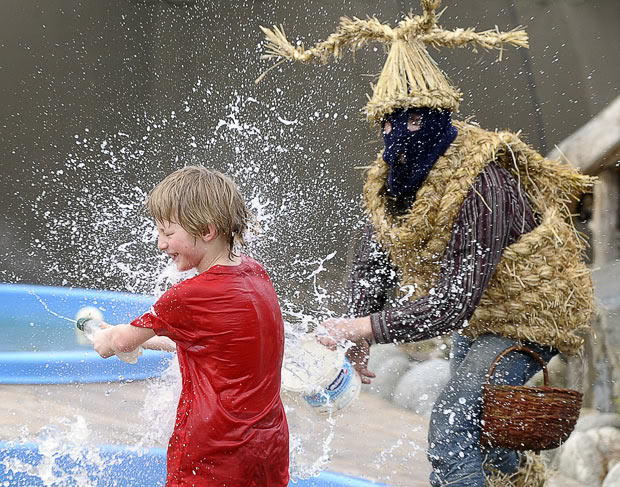Northern Europe: Easter fires

Easter is widely referred to as the holiest of Christian holidays, steeped in ancient traditions – including the Easter Vigil. During the vigil, new baptisms are performed and certain church officials ushered into their positions. This tradition has morphed over the last century in much of Northern Europe into a much more literal form of vigil, a gathering round the bonfire. This is apparently an expansion of the flame of a Paschal Candle, which acts as an important physical metaphor in many Christian ceremonies. The modern European practices have a more secular bent, with many smaller towns holding large-scale contests for the largest and neatest bonfire. These bonfires have made Easter one of the area’s premiere annual social events.
Haiti: Voodoo Easter

Haitians certainly take Easter seriously, though it may not resemble the holiday as you know it. Haiti has blended traditional Christian traditions with Voodoo beliefs, resulting in a whole week of celebrations called Holy Week. Holy Week features numerous parades and celebrations, but by far the biggest are on Good Friday, which is a national holiday. Many adherents of Voodoo travel to the town of Souvenance to pay homage to African spirits during this time, meaning that visitors have some choices of attraction; the major cities have an almost mardi gras style party for more Western tastes, while the rural areas offer a look at a truly different conception of Easter. Squeamish travellers are advised to look out for ceremonies involving animal sacrifices.
Sweden: Easter witches

The Easter witches are a bit of a point of pride in Sweden. The claim is that the truly ancient traditions of the Swedish people (though we have to go back so far that the term “Swedish” is fairly meaningless) predate the arrival of Christianity. This seemingly pagan modification to Easter is really a statement of individualism, and helps connect the Swedish people to their Easter celebration. Most of the actual dressing up is done by children, though, and adults tend to spend more time embracing the relaxed modern atmosphere surrounding merriment on Good Friday and Easter Sunday. As with most things in Sweden, Easter is a laid back holiday with an emphasis on personal enjoyment.
France: Easter omelette

It might not seem like much of a tradition, the French predilection toward omelettes on Easter, but as with anything it can be made world-famous simply by making it bigger. Beginning as an initiative to feed hungry people on the holy holiday, somehow the Easter omelette has progressed into a bit of a national competition. Many towns make enormous omelettes, but few can hope to compete with the town of Haut, which holds the record with a nearly 5000-egg omelette made in the town square. The haut omelette usually feeds between one and two thousand people, so be sure to show up early if you want a bite. Those travellers who don’t care about eating their bit of an historic foodstuff can easily replicate the experience in the surrounding towns and cities.
Norway: Paaske krim

Leave it to the Norwegians to keep using the word Easter even after changing the tradition beyond all recognition. Many residents of Norway celebrate Easter in a more traditional, religious way, but one large-scale practice in the Scandinavian country is Passke krim: a day spent skiing Norway’s famous mountains, then curled up with a good crime novel. It seems like a bit of a stereotype, to say that a nation full of people spend a holiday reading the best-sellers of Stieg Larsson and his contemporaries, but it’s the truth. If you’re looking for one of the most atypical Easter traditions around, Norway is the place to be. Coupled with some truly amazing annual sales and vacation deals, this holy weekend is one of the highlights of the year.
Greece: Pot throwing

The island of Corfu, Greece has created an odd tradition that has spread to much of the rest of the country. Each Easter Sunday, after the traditional mass often attended even by non-religious members of the community, the ringing of church bells signals the end of the ceremony. And then, another chorus rings through the air: the shattering of pottery. The bells provide a signal so the town’s inhabitants can coordinate their destructive celebration: every Easter, residents of Corfu and much of southern Greece and Italy celebrate Easter by hurling earthenware pots out of their windows to fill the streets with shards of hardened clay. It’s one of the most gleeful traditions on this list, and foreign travellers are welcome to join in the fun. Just find yourself a pot, and do as the Romans do.
Poland: Easter water-fight

Poland has a nice assortment of little traditions that, collectively, make this one of the quirkiest Easter destinations of all. Polish Christians attend church with palm leaf stand-ins like willow branches or flower bouquets. On the Saturday before Easter Sunday, families often bring a “blessing basket” full of basic foodstuffs to church so the priest can bless it, a practice that stems from the belief that such a blessing is required to end the fasting of lent (whether or not that fast is actually being observed). Young girls are often whipped (playfully) on the backs of their legs with the same sorts of plants, or sprinkling them with water. This gentle tradition has evolved a bit, becoming “Wet Monday,” which sees young people of both sexes roaming the streets with buckets of water to dump on one another.


